Can Isik
A Hybrid Intelligent System for Protection of Transmission Lines Connected to PV Farms based on Linear Trends
Jun 19, 2024Abstract:Conventional relays face challenges for transmission lines connected to inverter-based resources (IBRs). In this article, a single-ended intelligent protection of the transmission line in the zone between the grid and the PV farm is suggested. The method employs a fuzzy logic and random forest (RF)-based hybrid system to detect faults based on combined linear trend attributes of the 3-phase currents. The fault location is determined and the faulty phase is detected. RF feature selection is used to obtain the optimal linear trend feature. The performance of the methodology is examined for abnormal events such as faults, capacitor and load-switching operations simulated in PSCAD/EMTDC on IEEE 9-bus system obtained by varying various fault and switching parameters. Additionally, when validating the suggested strategy, consideration is given to the effects of conditions such as the presence of double circuit lines, PV capacity, sampling rate, data window length, noise, high impedance faults, CT saturation, compensation devices, evolving and cross-country faults, and far-end and near-end faults. The findings indicate that the suggested strategy can be used to deal with a variety of system configurations and situations while still safeguarding such complex power transmission networks.
Dictionary Attack on IMU-based Gait Authentication
Sep 21, 2023Abstract:We present a novel adversarial model for authentication systems that use gait patterns recorded by the inertial measurement unit (IMU) built into smartphones. The attack idea is inspired by and named after the concept of a dictionary attack on knowledge (PIN or password) based authentication systems. In particular, this work investigates whether it is possible to build a dictionary of IMUGait patterns and use it to launch an attack or find an imitator who can actively reproduce IMUGait patterns that match the target's IMUGait pattern. Nine physically and demographically diverse individuals walked at various levels of four predefined controllable and adaptable gait factors (speed, step length, step width, and thigh-lift), producing 178 unique IMUGait patterns. Each pattern attacked a wide variety of user authentication models. The deeper analysis of error rates (before and after the attack) challenges the belief that authentication systems based on IMUGait patterns are the most difficult to spoof; further research is needed on adversarial models and associated countermeasures.
Treadmill Assisted Gait Spoofing (TAGS): An Emerging Threat to wearable Sensor-based Gait Authentication
Dec 17, 2020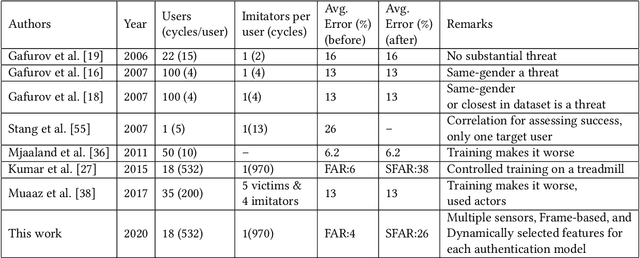


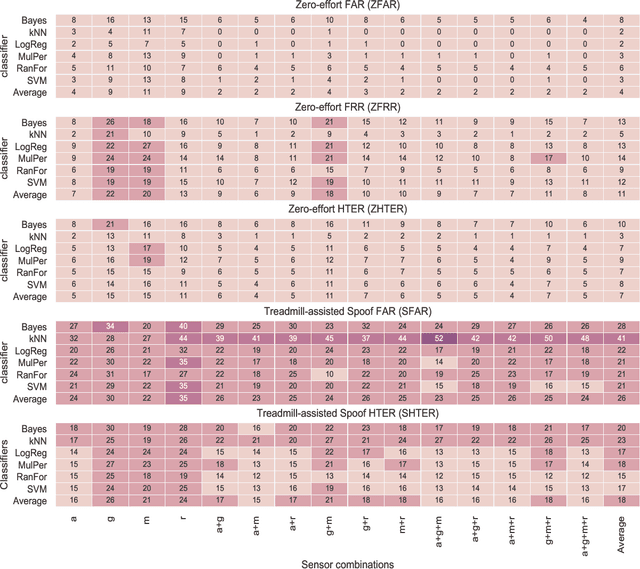
Abstract:In this work, we examine the impact of Treadmill Assisted Gait Spoofing (TAGS) on Wearable Sensor-based Gait Authentication (WSGait). We consider more realistic implementation and deployment scenarios than the previous study, which focused only on the accelerometer sensor and a fixed set of features. Specifically, we consider the situations in which the implementation of WSGait could be using one or more sensors embedded into modern smartphones. Besides, it could be using different sets of features or different classification algorithms, or both. Despite the use of a variety of sensors, feature sets (ranked by mutual information), and six different classification algorithms, TAGS was able to increase the average False Accept Rate (FAR) from 4% to 26%. Such a considerable increase in the average FAR, especially under the stringent implementation and deployment scenarios considered in this study, calls for a further investigation into the design of evaluations of WSGait before its deployment for public use.
Intelligent Protection & Classification of Transients in Two-Core Symmetric Phase Angle Regulating Transformers
Jun 17, 2020
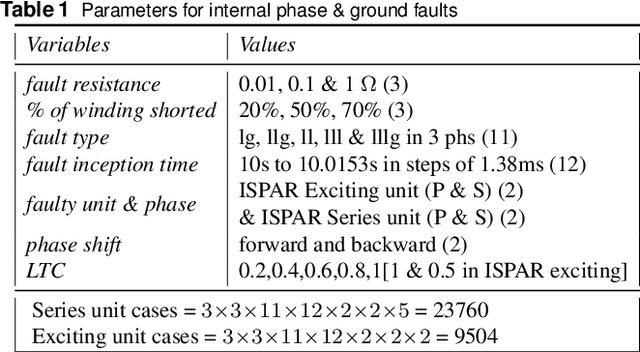
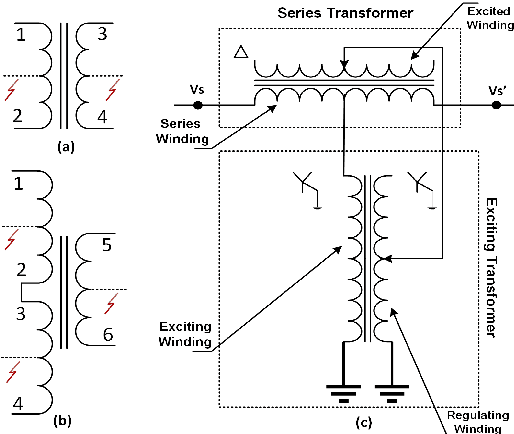
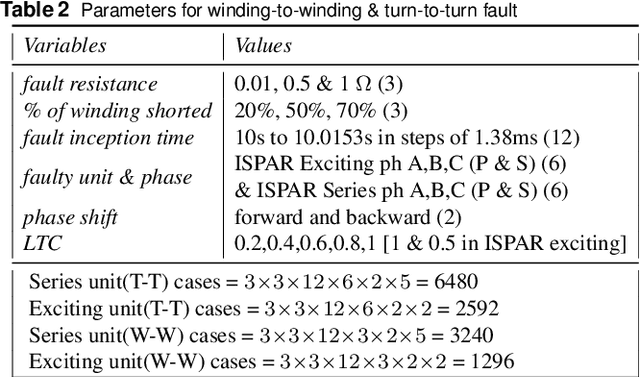
Abstract:This paper investigates the applicability of time and time-frequency features based classifiers to distinguish internal faults and other transients - magnetizing inrush, sympathetic inrush, external faults with current transformer saturation, and overexcitation - for Indirect Symmetrical Phase Angle Regulating Transformers (ISPAR). Then the faulty transformer unit (series/exciting) of the ISPAR is located, or else the transient disturbance is identified. An event detector detects variation in differential currents and registers one-cycle of 3-phase post transient samples which are used to extract the time and time-frequency features for training seven classifiers. Three different sets of features - wavelet coefficients, time-domain features, and combination of time and wavelet energy - obtained from exhaustive search using Decision Tree, random forest feature selection, and maximum Relevance Minimum Redundancy are used. The internal fault is detected with a balanced accuracy of 99.9%, the faulty unit is localized with balanced accuracy of 98.7% and the no-fault transients are classified with balanced accuracy of 99.5%. The results show potential for accurate internal fault detection and localization, and transient identification. The proposed scheme can supervise the operation of existing microprocessor-based differential relays resulting in higher stability and dependability. The ISPAR is modeled and the transients are simulated in PSCAD/EMTDC by varying several parameters.
Identification of Internal Faults in Indirect Symmetrical Phase Shift Transformers Using Ensemble Learning
Nov 12, 2018



Abstract:This paper proposes methods to identify 40 different types of internal faults in an Indirect Symmetrical Phase Shift Transformer (ISPST). The ISPST was modeled using Power System Computer Aided Design (PSCAD)/ Electromagnetic Transients including DC (EMTDC). The internal faults were simulated by varying the transformer tapping, backward and forward phase shifts, loading, and percentage of winding faulted. Data for 960 cases of each type of fault was recorded. A series of features were extracted for a, b, and c phases from time, frequency, time-frequency, and information theory domains. The importance of the extracted features was evaluated through univariate tests which helped to reduce the number of features. The selected features were then used for training five state-of-the-art machine learning classifiers. Extremely Random Trees and Random Forest, the ensemble-based learners, achieved the accuracy of 98.76% and 97.54% respectively outperforming Multilayer Perceptron (96.13%), Logistic Regression (93.54%), and Support Vector Machines (92.60%)
 Add to Chrome
Add to Chrome Add to Firefox
Add to Firefox Add to Edge
Add to Edge